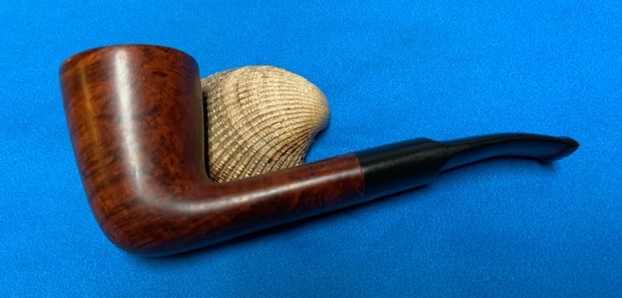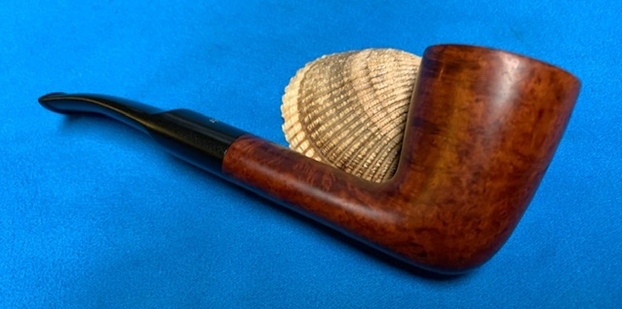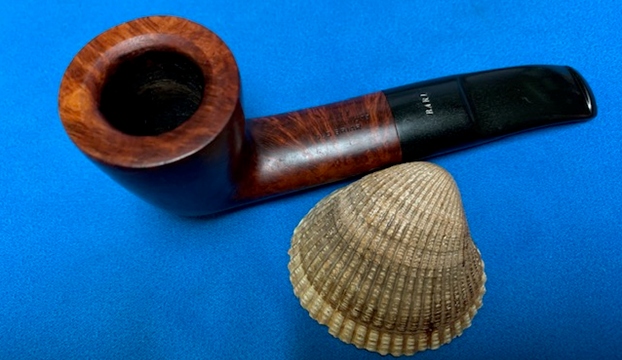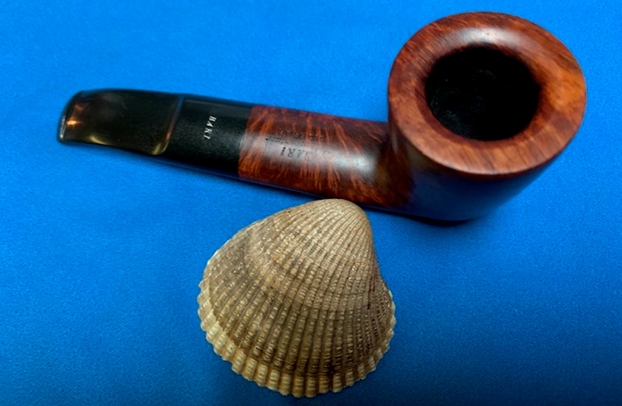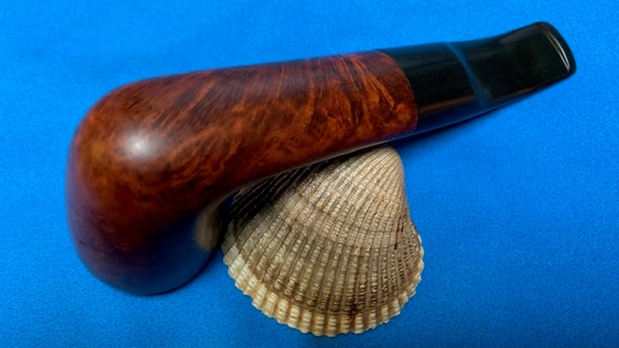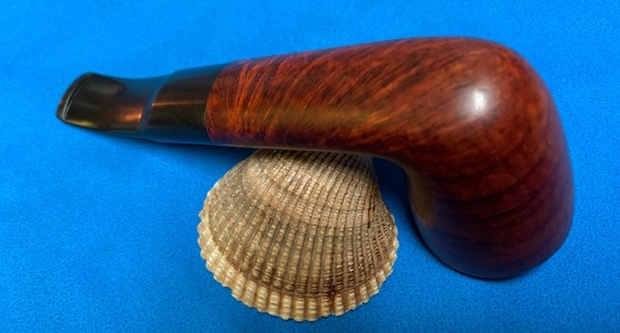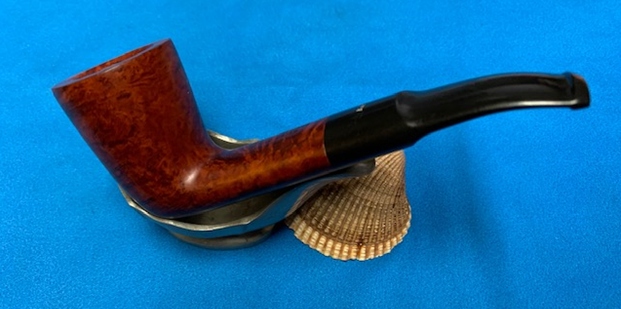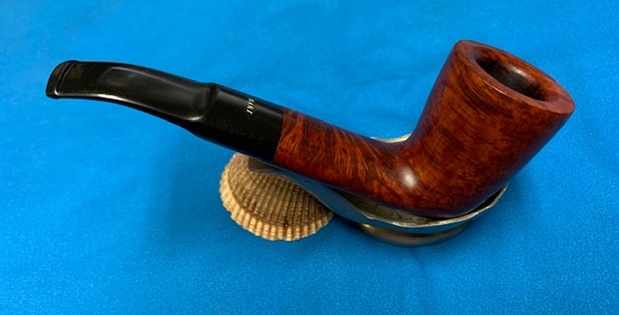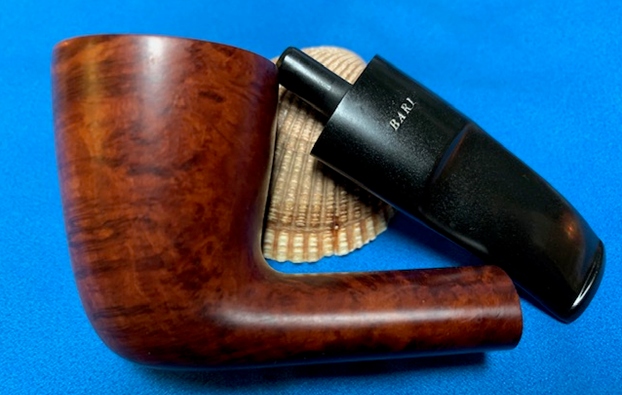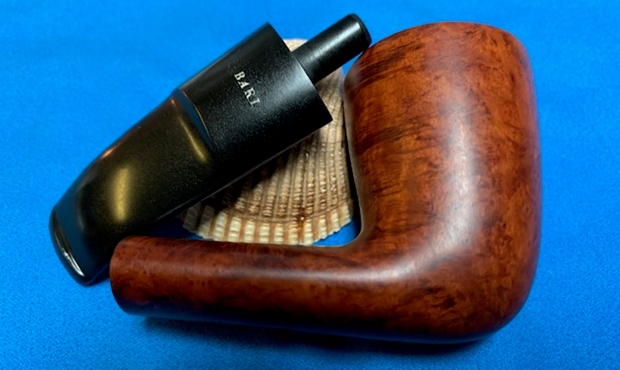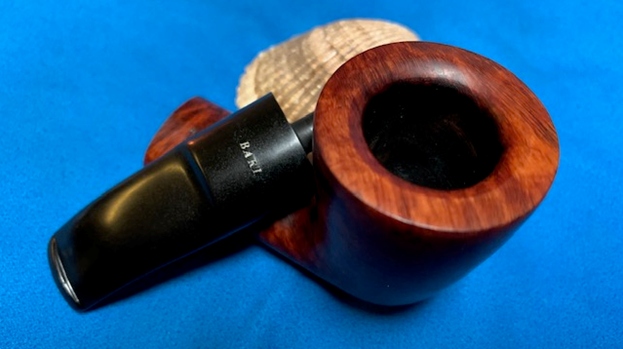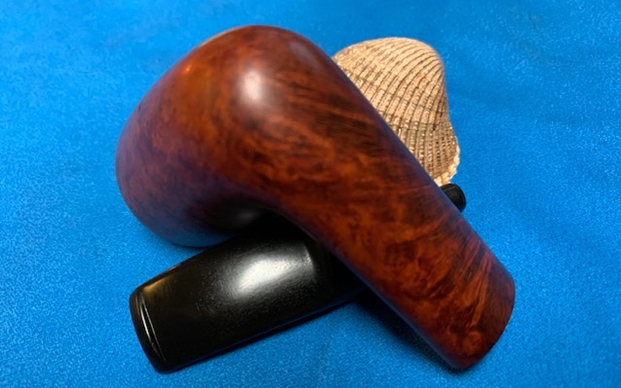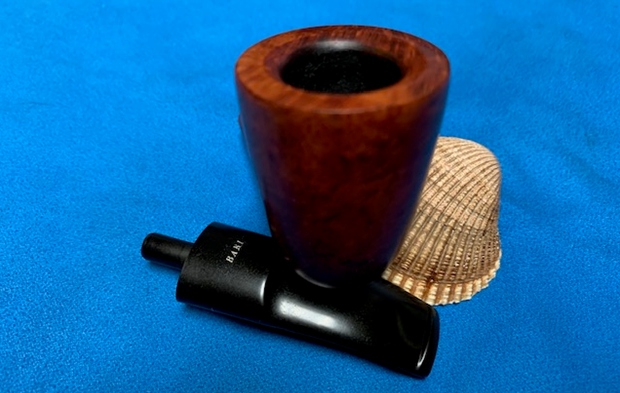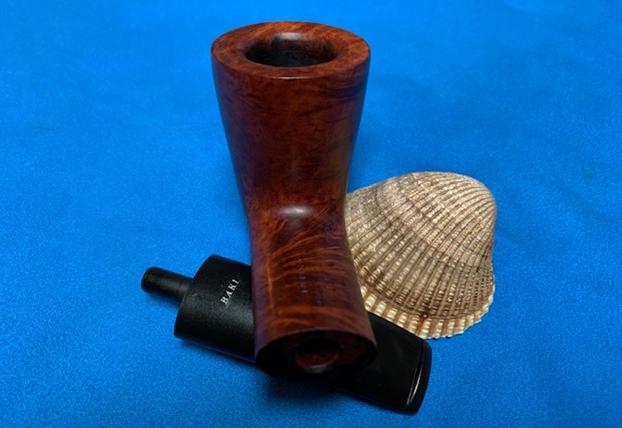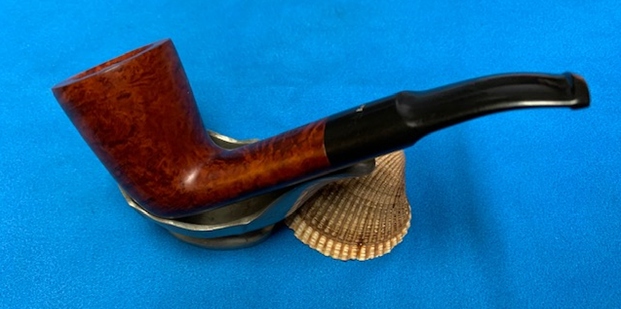Blog by Steve Laug
The next pipe on the work table came to us from an antique store in Bozeman, Montana, USA. The pipe is another interesting looking Bari pipe. It has a Danish take on an oval shank Dublin. It is a smooth finish pipe with some cross grain on the sides and running onto the underside of the shank as well as birdseye on the front and back and flowing on to the sides of the shank. The pipe is stamped on the topside of the shank and reads BARI [over] Select Nature [over] Old Briar. On the underside of the shank it is stamped Made in Denmark [over] the shape number 7980. There was a lot of grime ground into the smooth finish on the briar. The bowl was heavily caked with a lava coat flowing onto the top of the rim and in the beveled edge of the bowl – heavier toward the rear of the bowl. The inside and outside edges looked to be in good condition but we would know more once Jeff had cleaned it. The stem was oxidized, calcified and had tooth chatter and marks on the top and underside near the button. The BARI logo was stamped on the top side of the saddle. It had promise but it was very dirty. Jeff took some photos of the pipe before he started his cleanup work. 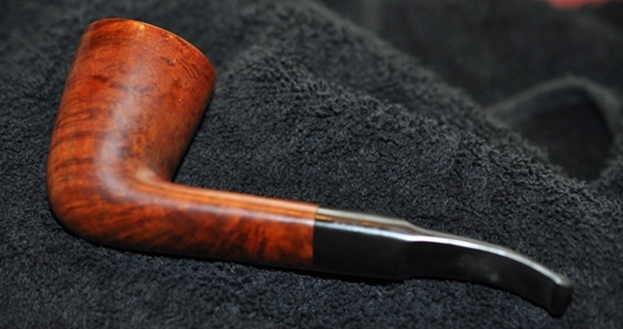
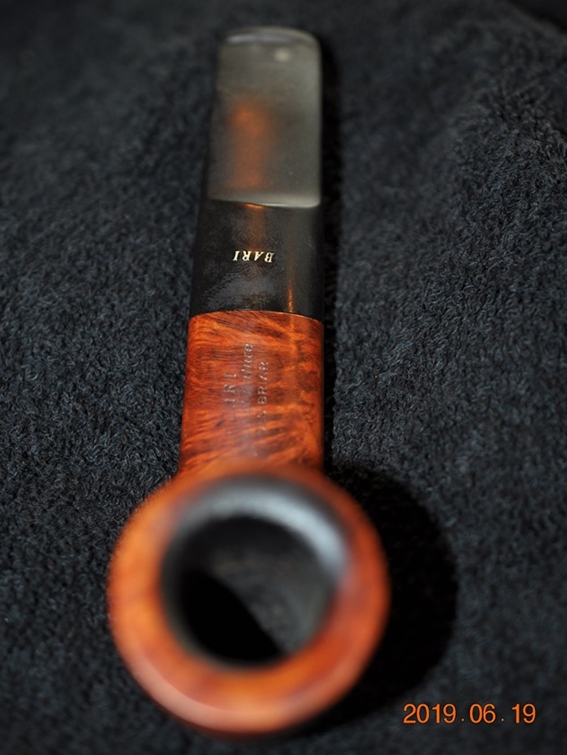 He took a photo of the rim top and bowl to give a clear picture of the thickness of the cake and tobacco debris as well as the lava on the rim top and inner beveled edge. He also took photos of the top and underside of the stem to show the oxidation and the chatter and tooth marks.
He took a photo of the rim top and bowl to give a clear picture of the thickness of the cake and tobacco debris as well as the lava on the rim top and inner beveled edge. He also took photos of the top and underside of the stem to show the oxidation and the chatter and tooth marks. 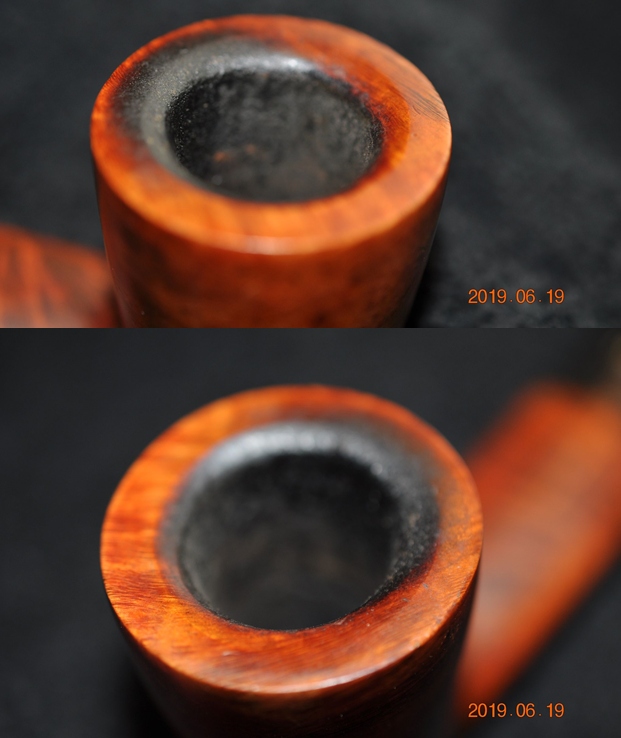
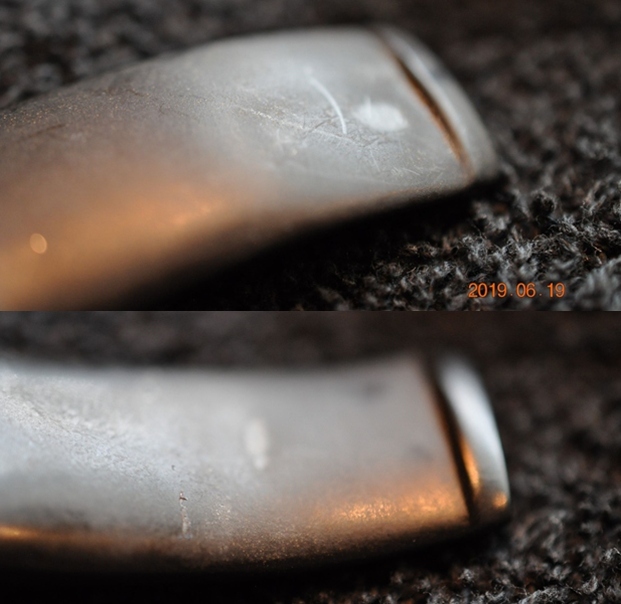 Jeff took photos of the sides and heel of the bowl to give a picture of what the briar looked like. There is some nice grain around the sides.
Jeff took photos of the sides and heel of the bowl to give a picture of what the briar looked like. There is some nice grain around the sides. 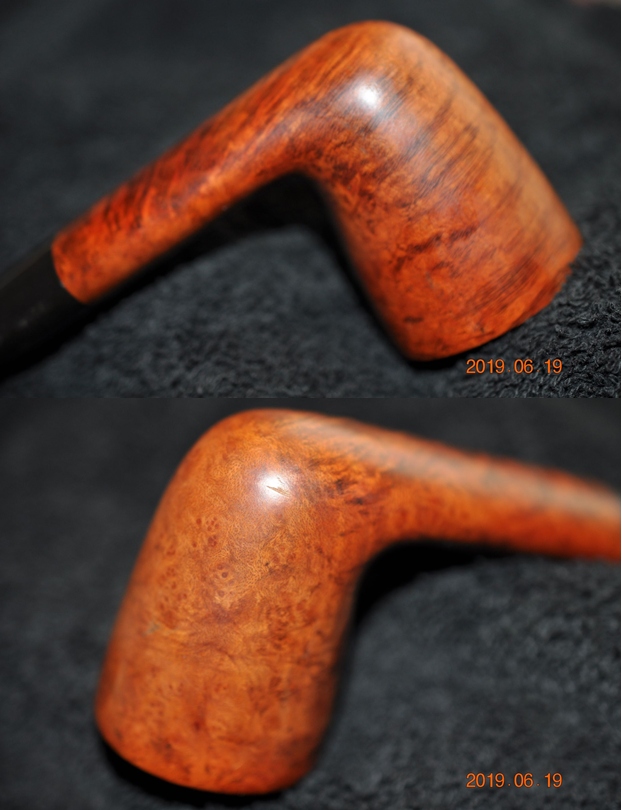 The stamping on the top and underside of the shank are clear and readable and read as noted above.
The stamping on the top and underside of the shank are clear and readable and read as noted above. 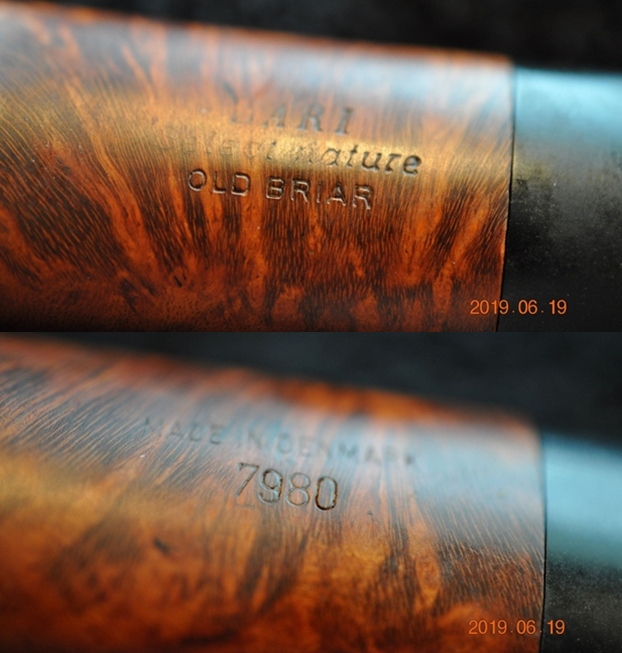
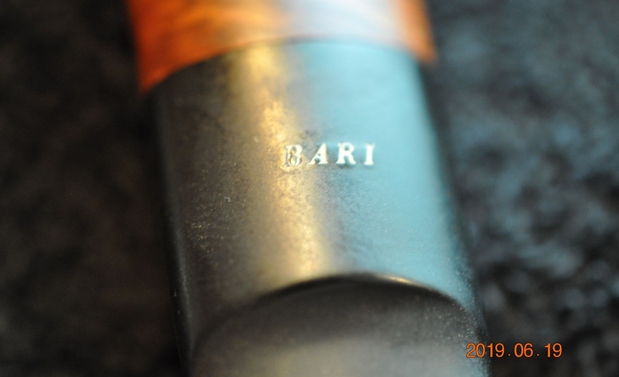 I turned to Pipephil’s site (http://www.pipephil.eu/logos/en/logo-b1.html) to see if I could find a listing for the Bari Selected Nature Old Briar. There was nothing specifically listed for this line of Bari pipes. There was also good info on the brand as a whole and that it was founded by Viggo Nielsen in 1950 and he ran it until 1978 when Age Bogelund managed the production for them. In 1993 it was sold to Helmer Thomsen.
I turned to Pipephil’s site (http://www.pipephil.eu/logos/en/logo-b1.html) to see if I could find a listing for the Bari Selected Nature Old Briar. There was nothing specifically listed for this line of Bari pipes. There was also good info on the brand as a whole and that it was founded by Viggo Nielsen in 1950 and he ran it until 1978 when Age Bogelund managed the production for them. In 1993 it was sold to Helmer Thomsen. Pipedia gives a great history of the brand (https://pipedia.org/wiki/Bari) that is well worth reading. There were also examples of the Bari Selected Nature Old Briar pipes showing their stamping.
Pipedia gives a great history of the brand (https://pipedia.org/wiki/Bari) that is well worth reading. There were also examples of the Bari Selected Nature Old Briar pipes showing their stamping.
Now on to working on the pipe. Jeff had cleaned up the pipe with his usual penchant for thoroughness. He reamed the pipe with a PipNet pipe reamer and removed the rest of it with a Savinelli Fitsall Pipe Knife. He scrubbed the bowl with undiluted Murphy’s Oil Soap with a tooth brush. He rinsed it under running warm water to remove the soap and grime. He cleaned out the inside of the shank and the airway in the stem with alcohol, cotton swabs and pipe cleaners. He soaked the stem in Before & After Deoxidizer and rinsed it off with warm water. I took photos of the pipe once I received it. 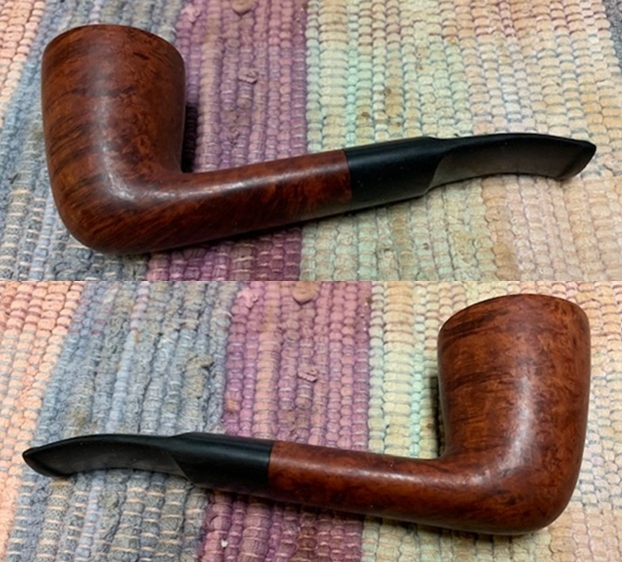
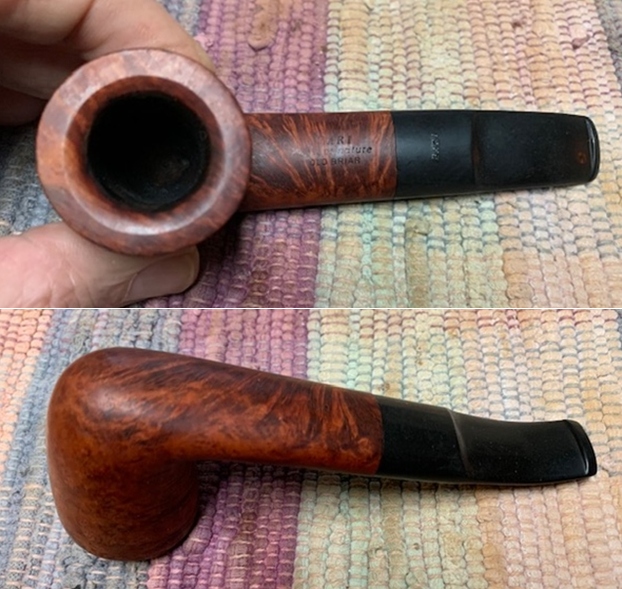 The rim top cleaned up really well. The rim top and outer edge of the bowl appear to be in good condition. The beveled inner edge also looked good. The stem surface looked good with a few small tooth marks and chatter on both sides near the button.
The rim top cleaned up really well. The rim top and outer edge of the bowl appear to be in good condition. The beveled inner edge also looked good. The stem surface looked good with a few small tooth marks and chatter on both sides near the button. 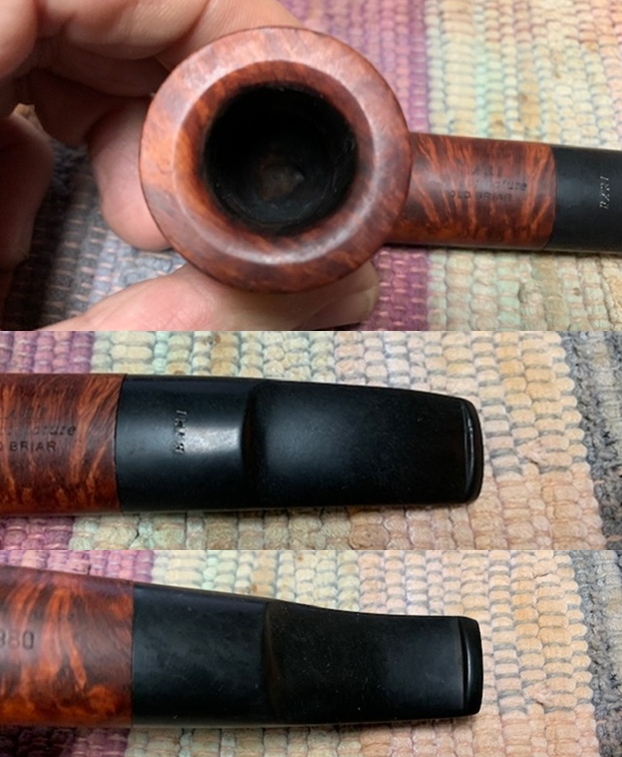 The stamping on both sides of the shank is clear and readable and reads as noted above. I took a photo of the stamping on the top of the shank to show the general condition of the stamping.
The stamping on both sides of the shank is clear and readable and reads as noted above. I took a photo of the stamping on the top of the shank to show the general condition of the stamping. 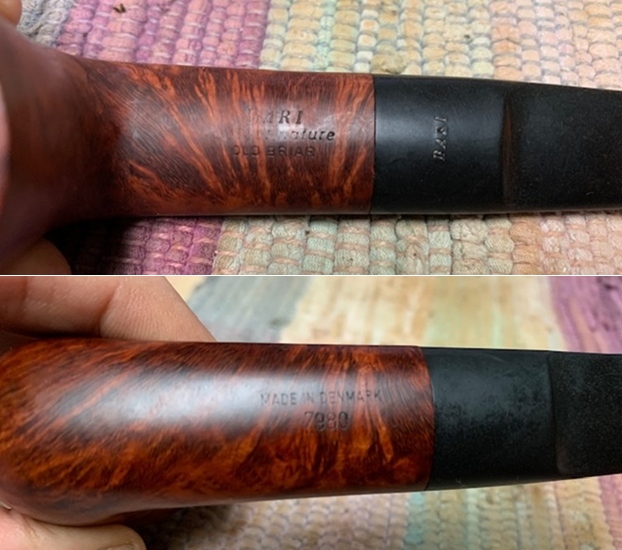 I removed the stem and took a photo of the pipe to give a sense of the whole. The stem is an oval saddle with BARI stamped on the topside.
I removed the stem and took a photo of the pipe to give a sense of the whole. The stem is an oval saddle with BARI stamped on the topside.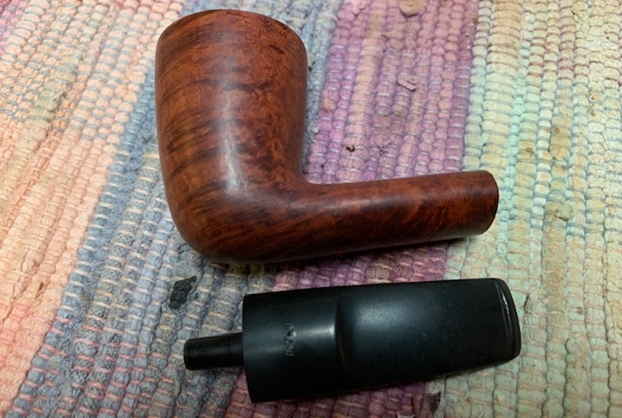 Now it was time to do my work on the pipe. The bowl was in such good condition that I polished the briar with micromesh sanding pads – wet sanding with 1500-12000 grit pads and wiping it down after each pad with a damp cloth.
Now it was time to do my work on the pipe. The bowl was in such good condition that I polished the briar with micromesh sanding pads – wet sanding with 1500-12000 grit pads and wiping it down after each pad with a damp cloth.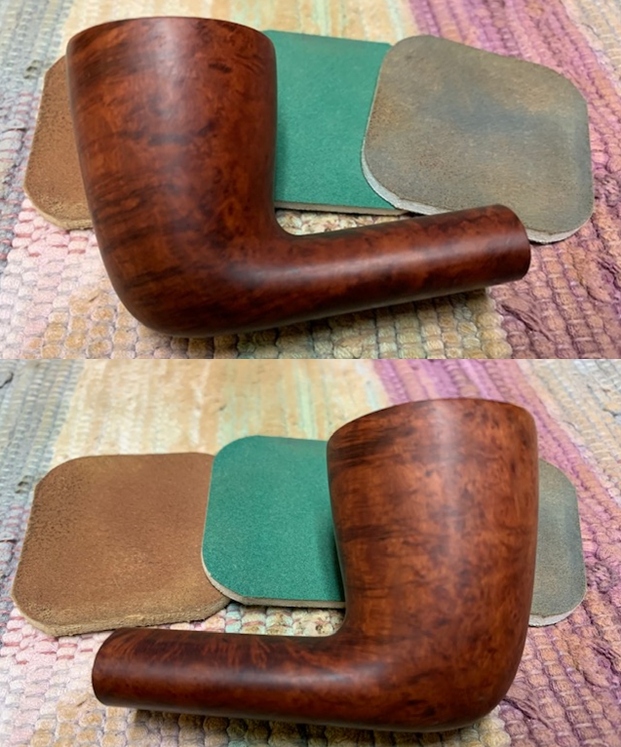
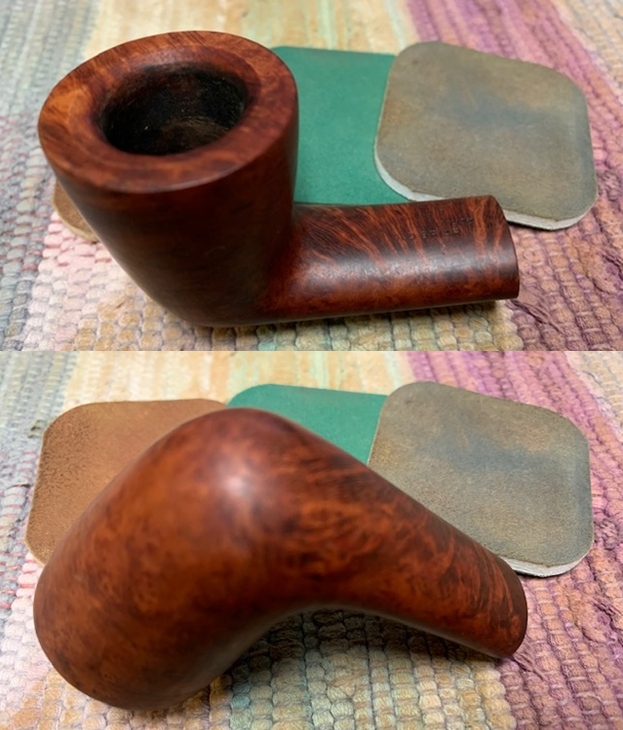
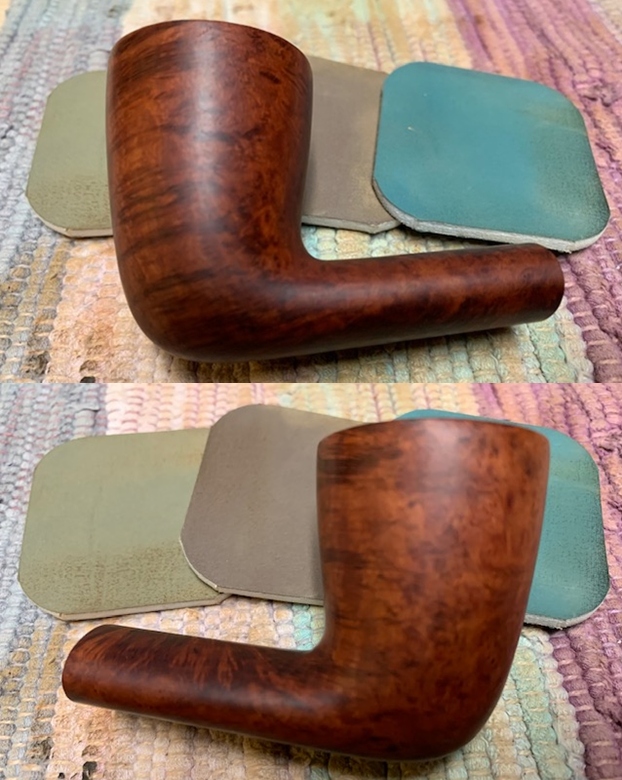
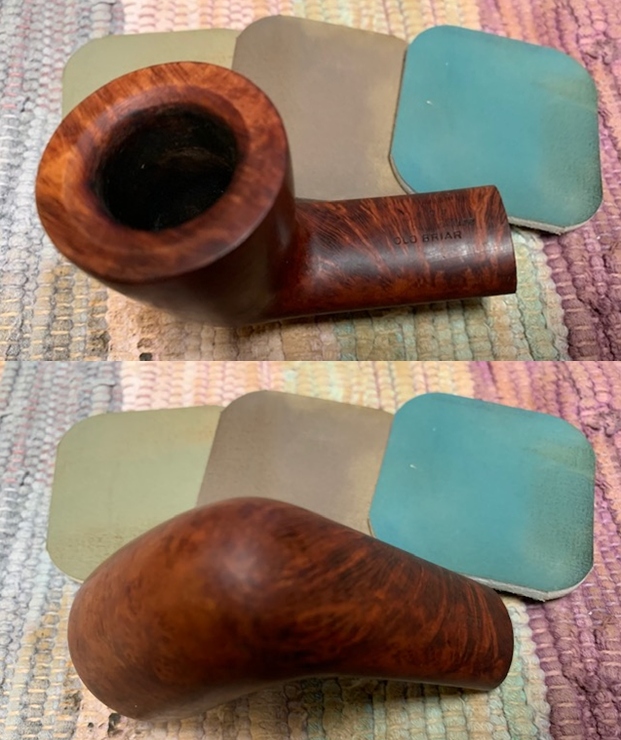
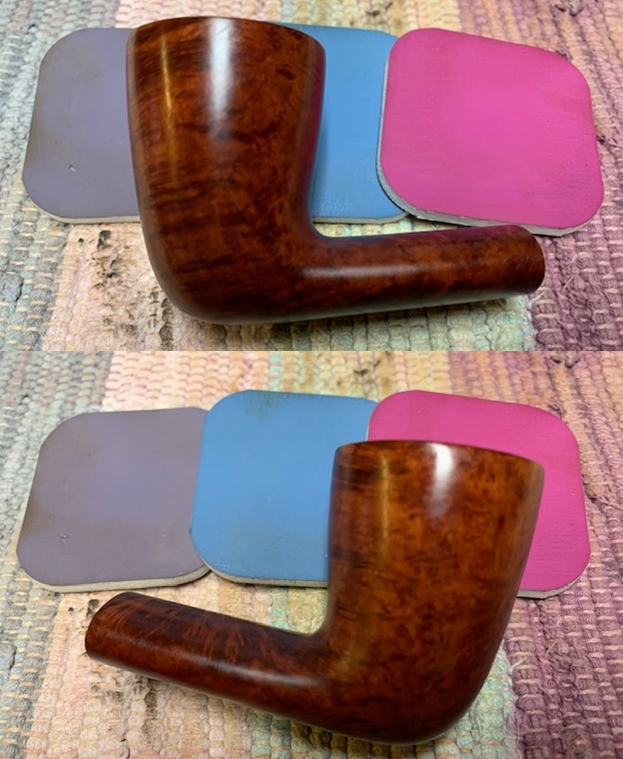
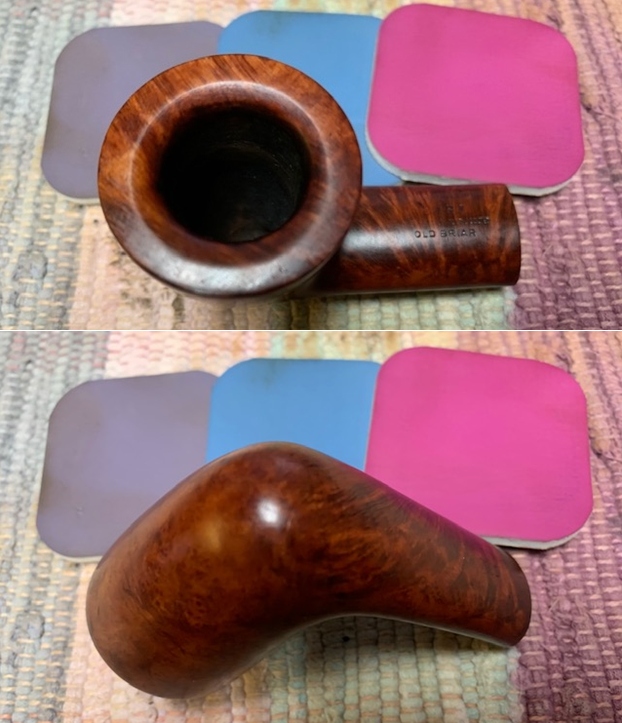 I rubbed the bowl and shank down with Before & After Restoration Balm. I worked it into the surface of the bowl sides and shank with my fingertips to clean, enliven and protect the briar. I let the balm sit for a little while and then buffed with a cotton cloth to raise the shine. The grain came alive and the fills while visible look better than when I began.
I rubbed the bowl and shank down with Before & After Restoration Balm. I worked it into the surface of the bowl sides and shank with my fingertips to clean, enliven and protect the briar. I let the balm sit for a little while and then buffed with a cotton cloth to raise the shine. The grain came alive and the fills while visible look better than when I began. 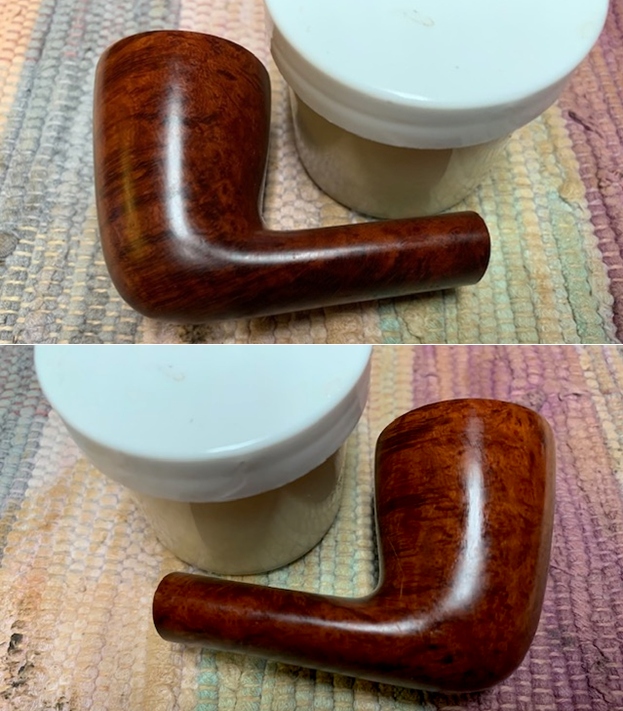
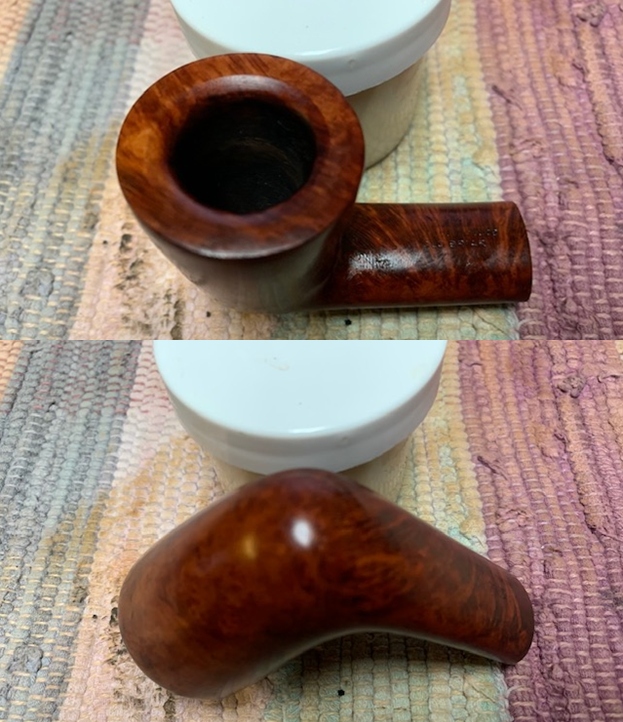
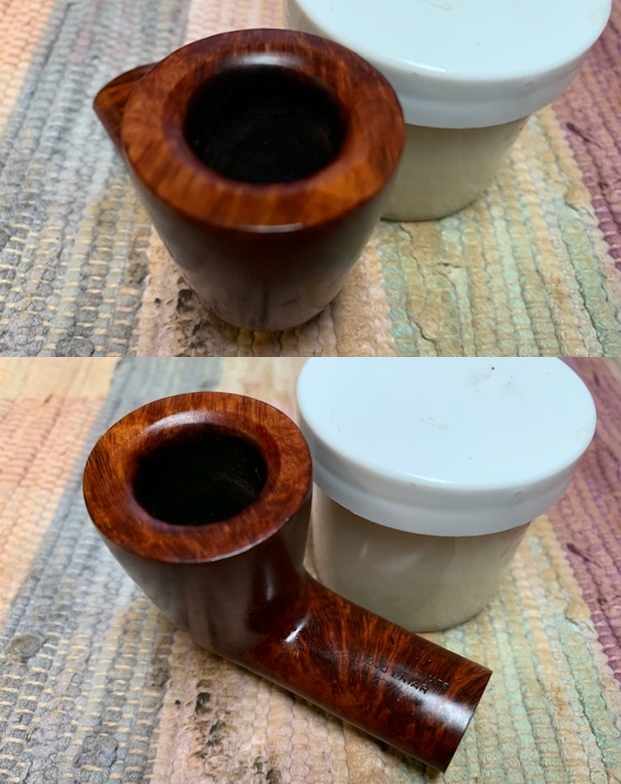 I set the bowl aside and turned my attention to the stem. I “painted” the surface of the stem with the flame of a lighter to lift the tooth marks. It worked very well and the marks lifted. I was able to sand out the remnants of tooth marks with 220 grit sandpaper. I started the polishing with 400 grit sandpaper.
I set the bowl aside and turned my attention to the stem. I “painted” the surface of the stem with the flame of a lighter to lift the tooth marks. It worked very well and the marks lifted. I was able to sand out the remnants of tooth marks with 220 grit sandpaper. I started the polishing with 400 grit sandpaper. 
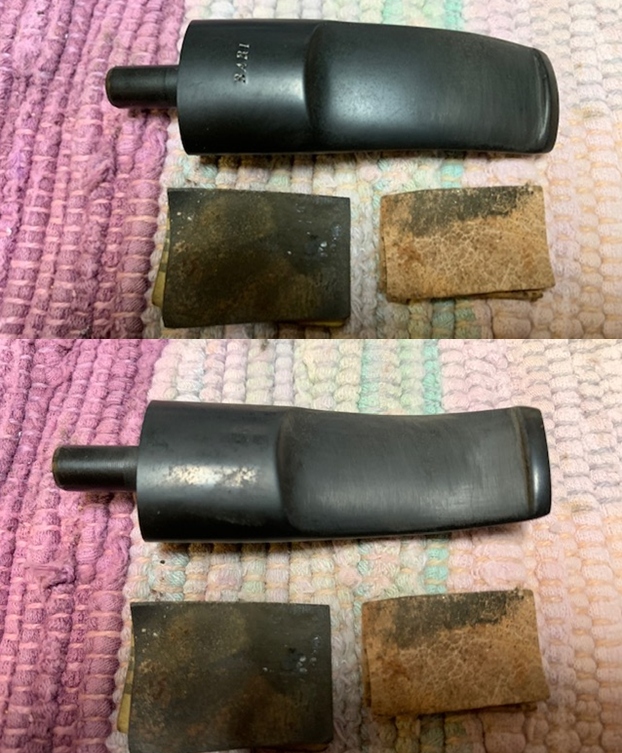 I touched up the BARI stamp on the top of the saddle with PaperMate Liquid Paper. I daubed it onto the stamping and worked it into the stamp with a tooth pick. Once it dried I scraped off the excess and left the white in the stamping.
I touched up the BARI stamp on the top of the saddle with PaperMate Liquid Paper. I daubed it onto the stamping and worked it into the stamp with a tooth pick. Once it dried I scraped off the excess and left the white in the stamping. I set the bowl aside and turned to work on the stem. It was in good condition and the tooth marks were light so I figured they would polish out fairly easily. I polished the vulcanite stem with micromesh sanding pads – 1500-12000 grit pads. I wiped it down with Obsidian Oil after each sanding pad. I used Before & After Pipe Polish – both Fine and Extra Fine to further polish the stem.
I set the bowl aside and turned to work on the stem. It was in good condition and the tooth marks were light so I figured they would polish out fairly easily. I polished the vulcanite stem with micromesh sanding pads – 1500-12000 grit pads. I wiped it down with Obsidian Oil after each sanding pad. I used Before & After Pipe Polish – both Fine and Extra Fine to further polish the stem. 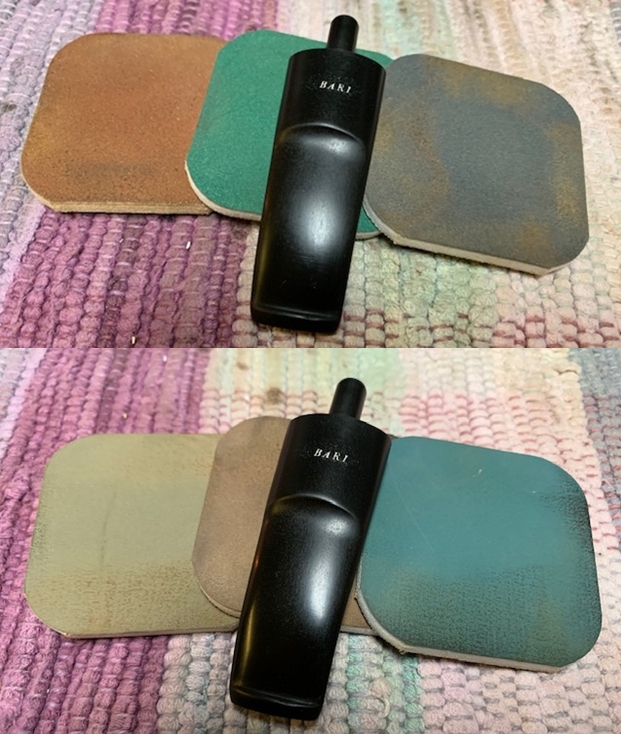
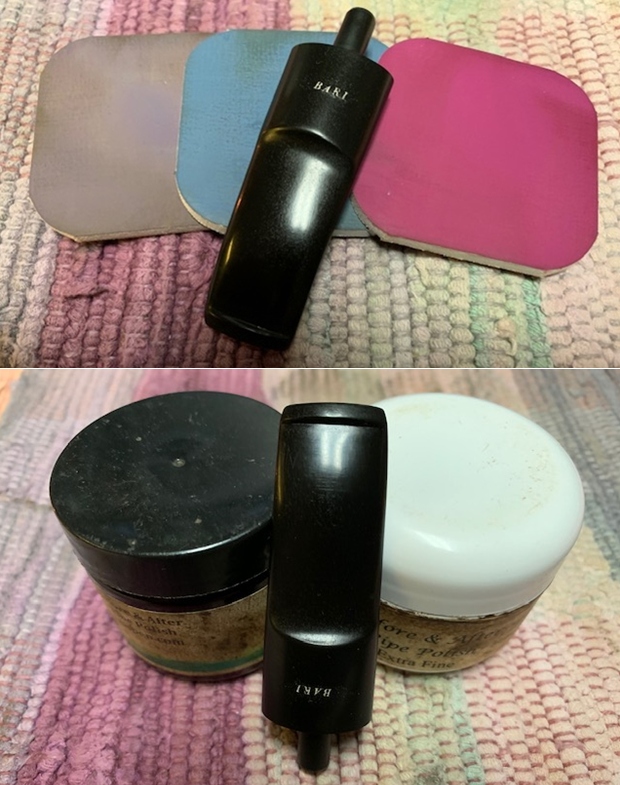 This Bari Select Nature Old Briar 7980 Dublin is a great looking pipe now that it has been restored. The smooth brown stained finish around the bowl is quite beautiful and highlights the grain and works well with the polished vulcanite oval saddle stem. I put the stem back on the bowl and carefully buffed the pipe with Blue Diamond on the buffing wheel using a light touch on the briar. I gave the bowl and the stem multiple coats of carnauba wax on the buffing wheel and followed that by buffing the entire pipe with a clean buffing pad. I hand buffed the pipe with a microfiber cloth to deepen the shine. The finished Bari Select Nature Dublin sits nicely in the hand and feels great. Give the finished pipe a look in the photos below. The dimensions of the pipe are Length: 5 inches, Height: 2 inches, Outside diameter of the bowl: 1 ½ inches, Chamber diameter: ¾ of an inch. I will be putting it on the rebornpipes store shortly. If you are interested in adding this pipe to your collection send me a message or an email. Thanks for reading this blog and my reflections on the pipe while I worked on it. There are many more to come!
This Bari Select Nature Old Briar 7980 Dublin is a great looking pipe now that it has been restored. The smooth brown stained finish around the bowl is quite beautiful and highlights the grain and works well with the polished vulcanite oval saddle stem. I put the stem back on the bowl and carefully buffed the pipe with Blue Diamond on the buffing wheel using a light touch on the briar. I gave the bowl and the stem multiple coats of carnauba wax on the buffing wheel and followed that by buffing the entire pipe with a clean buffing pad. I hand buffed the pipe with a microfiber cloth to deepen the shine. The finished Bari Select Nature Dublin sits nicely in the hand and feels great. Give the finished pipe a look in the photos below. The dimensions of the pipe are Length: 5 inches, Height: 2 inches, Outside diameter of the bowl: 1 ½ inches, Chamber diameter: ¾ of an inch. I will be putting it on the rebornpipes store shortly. If you are interested in adding this pipe to your collection send me a message or an email. Thanks for reading this blog and my reflections on the pipe while I worked on it. There are many more to come!